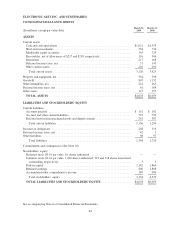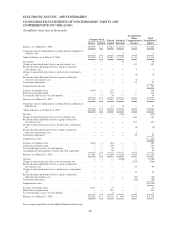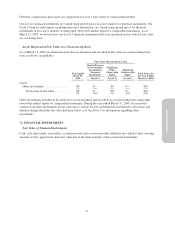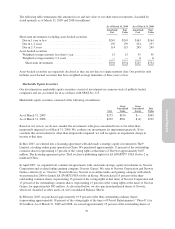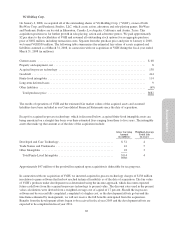Electronic Arts 2009 Annual Report Download - page 153
Download and view the complete annual report
Please find page 153 of the 2009 Electronic Arts annual report below. You can navigate through the pages in the report by either clicking on the pages listed below, or by using the keyword search tool below to find specific information within the annual report.
Annual Report
Sales Returns and Allowances and Bad Debt Reserves
We estimate potential future product returns, price protection and stock-balancing programs related to product
revenue. We analyze historical returns, current sell-through of distributor and retailer inventory of our products,
current trends in retail and the video game segment, changes in customer demand and acceptance of our products
and other related factors when evaluating the adequacy of our sales returns and price protection allowances. In
addition, we monitor the volume of sales to our channel partners and their inventories as substantial overstocking
in the distribution channel could result in high returns or higher price protection costs in subsequent periods.
Similarly, significant judgment is required to estimate our allowance for doubtful accounts in any accounting
period. We analyze customer concentrations, customer credit-worthiness, current economic trends, and historical
experience when evaluating the adequacy of the allowance for doubtful accounts.
Advertising Costs
We generally expense advertising costs as incurred, except for production costs associated with media
campaigns, which are recognized as prepaid assets (to the extent paid in advance) and expensed at the first run of
the advertisement. Cooperative advertising with our channel partners is accrued when revenue is recognized and
such amounts are included in marketing and sales expense if there is a separate identifiable benefit for which we
can reasonably estimate the fair value of the benefit identified. Otherwise, they are recognized as a reduction of
net revenue. We then reimburse the channel partner when qualifying claims are submitted. We sometimes
receive reimbursements for advertising costs from our vendors, and such amounts are recognized as a reduction
of marketing and sales expense if the advertising (1) is specific to the vendor, (2) represents an identifiable
benefit to us, and (3) represents an incremental cost to us. Otherwise, vendor reimbursements are recognized as a
reduction of cost of goods sold as the related revenue is recognized. Vendor reimbursements of advertising costs
of $31 million, $54 million and $28 million reduced marketing and sales expense for the fiscal years ended
March 31, 2009, 2008 and 2007, respectively. For the fiscal years ended March 31, 2009, 2008 and 2007,
advertising expense, net of vendor reimbursements, totaled approximately $270 million, $234 million and $163
million, respectively.
Software Development Costs
Research and development costs, which consist primarily of software development costs, are expensed as
incurred. SFAS No. 86, Accounting for the Cost of Computer Software to be Sold, Leased, or Otherwise
Marketed, provides for the capitalization of certain software development costs incurred after technological
feasibility of the software is established or for development costs that have alternative future uses. Under our
current practice of developing new products, the technological feasibility of the underlying software is not
established until substantially all product development and testing is complete, which generally includes the
development of a working model. The software development costs that have been capitalized to date have been
insignificant.
Stock-Based Compensation
We recognize the cost resulting from all share-based payment transactions in our financial statements using a
fair-value-based method. Upon adoption of SFAS No. 123 (revised 2004) (“SFAS No. 123(R)”), Share-Based
Payment, we elected to use the modified prospective transition method of adoption. We measure compensation
cost for all outstanding unvested stock-based awards made to our employees and directors based on estimated
fair values and recognize compensation over the service period for awards expected to vest.
The estimated fair value of stock options and stock purchase rights granted pursuant to our employee stock
purchase plan is determined using the Black-Scholes valuation model. The Black-Scholes valuation model
requires us to make certain assumptions about the future. Estimation of these equity instruments’ fair value is
affected by our stock price, as well as assumptions regarding subjective and complex variables such as expected
employee exercise behavior and our expected stock price volatility over the term of the award. Generally, our
assumptions are based on historical information and judgment is required to determine if historical trends may be
indicators of future outcomes.
73



